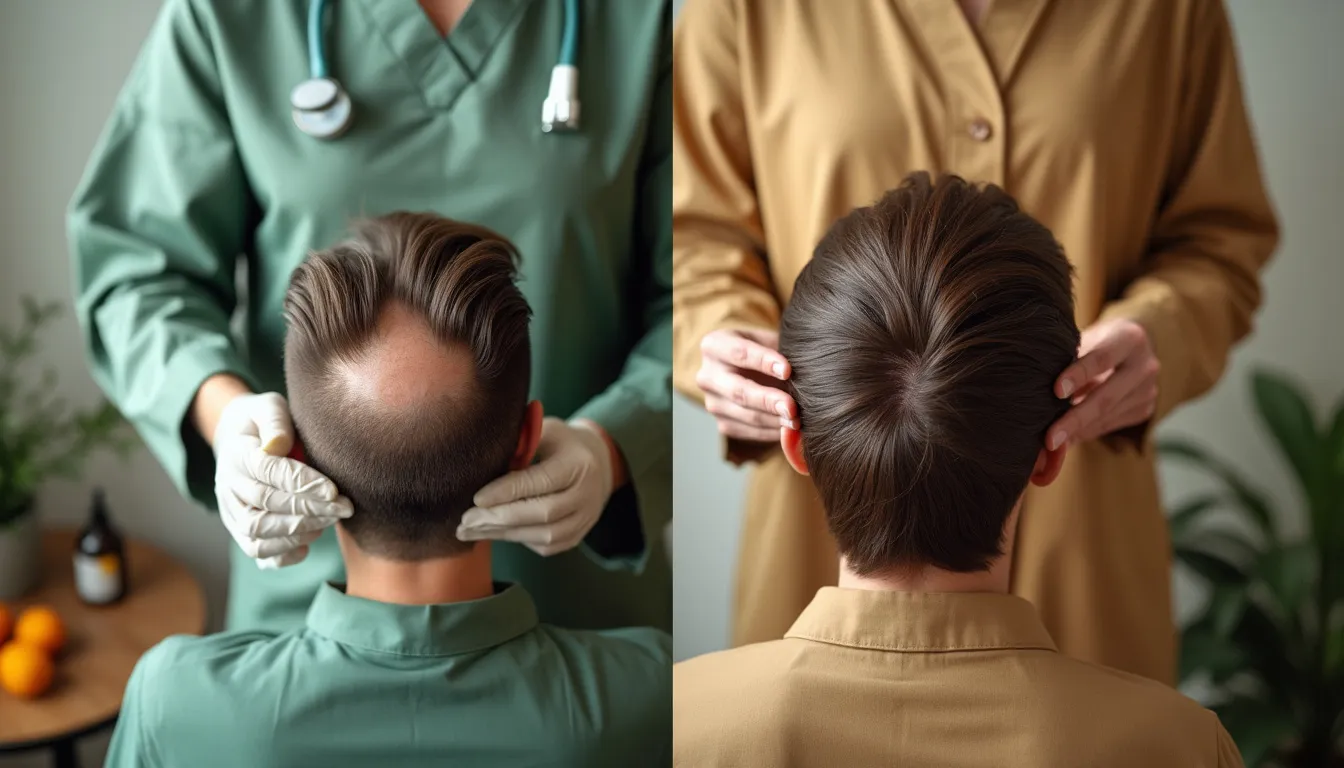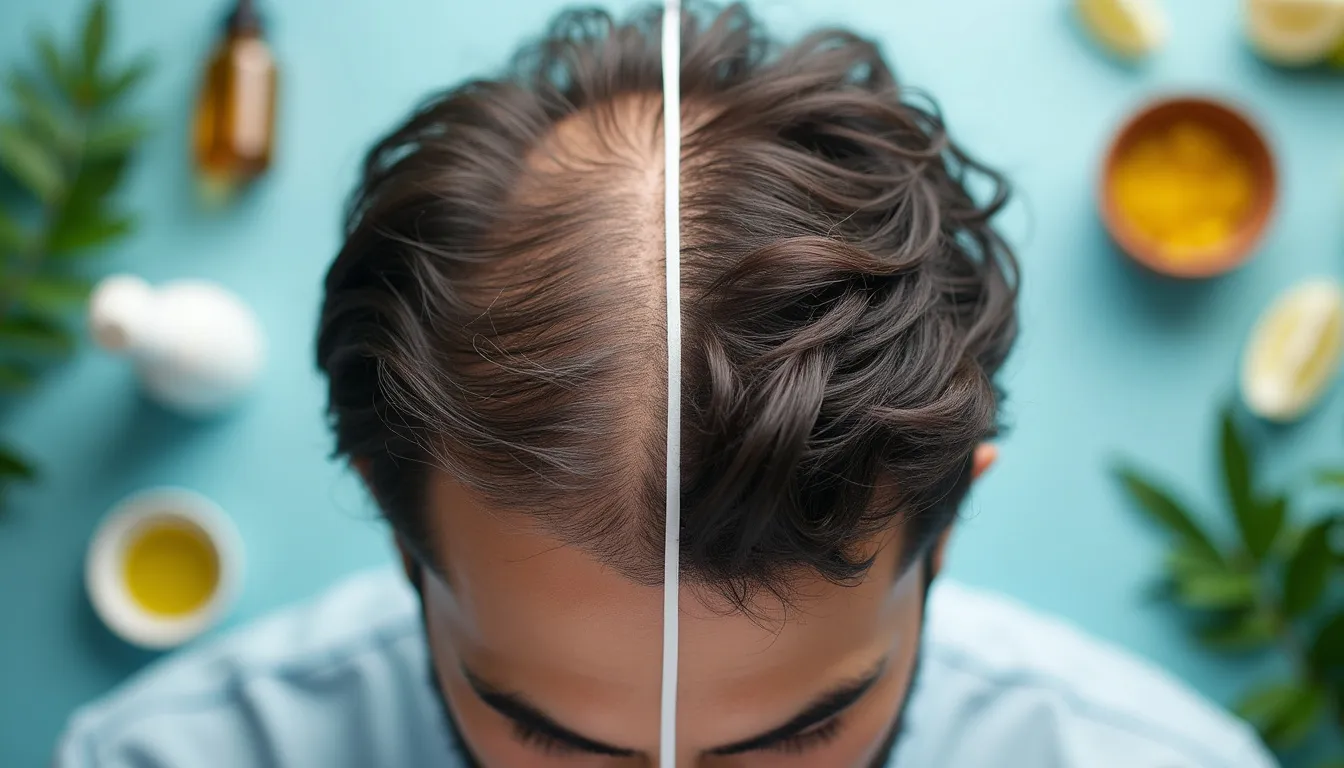Are you tired of watching your hairline recede or noticing thinning patches on your scalp? You’re not alone. Hair loss affects millions of people worldwide, impacting both men and women of all ages. The good news is that modern hair restoration techniques have come a long way, offering hope and solutions for those seeking to regain their fuller locks. In this comprehensive guide, we’ll delve into the world of hair restoration, exploring cutting-edge treatments that can help you reclaim your confidence and your hair. From understanding the root causes of hair loss to examining advanced procedures like Follicular Unit Transplantation (FUT) and Platelet-Rich Plasma (PRP) therapy, we’ll cover everything you need to know to make an informed decision about your hair restoration journey. Whether you’re just starting to notice hair thinning or you’ve been battling baldness for years, this article will equip you with the knowledge to take control of your hair health and explore the exciting possibilities that modern hair restoration techniques have to offer. So, let’s embark on this hair-raising adventure and discover how you can achieve the luscious locks you’ve always dreamed of!
Understanding Hair Loss and Its Causes
Hair loss is a common concern that affects millions of people worldwide, regardless of age or gender. Before diving into the world of hair restoration techniques, it’s crucial to understand the root causes of hair loss and the different types that people may experience. This knowledge can help you make informed decisions about the best course of action for your unique situation.
Common Types of Hair Loss
Hair loss comes in various forms, each with its own set of characteristics and underlying causes. Here are some of the most prevalent types:
- Androgenetic Alopecia: Also known as male or female pattern baldness, this is the most common type of hair loss. It’s influenced by genetics and hormones, particularly dihydrotestosterone (DHT).
- Alopecia Areata: An autoimmune condition that causes hair to fall out in small, round patches. It can affect any hair-bearing area of the body.
- Telogen Effluvium: A temporary form of hair loss often triggered by stress, illness, or significant life events. It typically resolves on its own within 6-12 months.
- Traction Alopecia: Caused by repeated pulling or tension on the hair, often due to tight hairstyles or excessive use of hair extensions.
- Scarring Alopecia: A group of disorders that destroy hair follicles, replacing them with scar tissue, leading to permanent hair loss.
Understanding which type of hair loss you’re experiencing is crucial in determining the most effective hair restoration approach. For instance, while androgenetic alopecia might respond well to transplantation techniques, alopecia areata may require a different treatment strategy altogether.
Factors Contributing to Hair Thinning
Hair thinning is often a precursor to more noticeable hair loss. Several factors can contribute to this process:
- Genetics: Your family history plays a significant role in determining your likelihood of experiencing hair loss.
- Hormonal Changes: Fluctuations in hormones, such as those occurring during pregnancy, menopause, or thyroid disorders, can affect hair growth.
- Nutritional Deficiencies: Lack of essential nutrients like iron, protein, and vitamins can lead to hair thinning.
- Medications: Certain drugs, including those used for cancer, arthritis, depression, and high blood pressure, can cause hair loss as a side effect.
- Stress: Both physical and emotional stress can trigger hair thinning and loss.
- Hairstyling Practices: Excessive use of heat styling tools, harsh chemical treatments, and tight hairstyles can damage hair and lead to thinning.
- Age: As we get older, hair naturally becomes finer and grows more slowly.
Identifying the factors contributing to your hair thinning can help in addressing the issue more effectively. For example, if nutritional deficiencies are the culprit, dietary changes and supplements might be beneficial before considering more invasive hair restoration techniques.
The Psychological Impact of Hair Loss
While hair loss is often viewed as a cosmetic issue, its impact on mental health and well-being shouldn’t be underestimated. Hair is closely tied to our identity and self-image, and losing it can lead to:
- Decreased self-esteem and confidence
- Anxiety and depression
- Social withdrawal
- Negative body image
- Reduced quality of life
Studies have shown that hair loss can significantly affect an individual’s psychological state. A survey published in the British Journal of Dermatology found that 40% of women with alopecia reported marital problems, and 63% claimed to have career-related problems.
Recognizing the emotional toll of hair loss is an important step in the journey towards hair restoration. It’s not just about regaining hair; it’s about restoring confidence and improving overall quality of life. This understanding can be a powerful motivator in seeking effective hair restoration solutions.
For those struggling with the psychological effects of hair loss, it’s essential to seek support. This could involve talking to a therapist, joining support groups, or exploring hair restoration options. Remember, you’re not alone in this journey, and there are numerous resources available to help you cope with the emotional aspects of hair loss.
As we delve deeper into the world of hair restoration techniques, keep in mind that addressing the underlying causes and emotional impact of hair loss is just as important as choosing the right restoration method. By taking a holistic approach, you’re more likely to achieve satisfying and long-lasting results.
If you’re ready to take the next step in your hair restoration journey, consider exploring programs designed to help stop hair loss, such as the one offered at Hair Security’s Fortify program. Remember, the key to successful hair restoration lies in understanding your unique situation and choosing a solution that addresses both the physical and emotional aspects of hair loss.

Advanced Hair Restoration Techniques
As the field of hair restoration continues to evolve, innovative techniques are emerging to help those struggling with hair loss regain their confidence and achieve fuller, natural-looking locks. Let’s dive into some of the most advanced hair restoration techniques available today.
Follicular Unit Transplantation (FUT)
Follicular Unit Transplantation, commonly known as FUT, is a surgical hair restoration technique that has been a game-changer in the field. This method involves removing a strip of skin with healthy hair follicles from the back of the scalp, typically referred to as the donor area.
Here’s how the FUT process works:
- A strip of scalp is surgically removed from the donor area
- The strip is divided into individual follicular units under a microscope
- These units are then carefully transplanted into the balding or thinning areas
While FUT can provide excellent results, it does leave a linear scar in the donor area. However, this scar is usually easily concealed by surrounding hair. FUT is often recommended for patients requiring a large number of grafts, as it allows for the harvesting of a significant amount of hair in a single session.
Follicular Unit Extraction (FUE)
Follicular Unit Extraction, or FUE, is another popular hair restoration technique that has gained traction in recent years. Unlike FUT, FUE doesn’t involve removing a strip of scalp. Instead, individual follicular units are extracted directly from the donor area.
The FUE process involves:
- Using a micro-punch tool to extract individual follicular units
- Creating tiny recipient sites in the balding areas
- Carefully implanting the extracted follicles into these sites
FUE is less invasive than FUT and doesn’t leave a linear scar. This makes it an attractive option for patients who prefer to wear their hair very short. However, FUE typically takes longer to perform and may be more expensive than FUT.
Scalp Micropigmentation (SMP)
For those looking for a non-surgical option, Scalp Micropigmentation (SMP) offers an innovative solution. SMP is essentially a cosmetic tattoo that mimics the appearance of a closely-shaved head or adds density to thinning areas.
The SMP process involves:
- Using specialized pigments and needles to create tiny, hair-like dots on the scalp
- Carefully matching the pigment color to the patient’s natural hair color
- Creating a natural-looking hairline and adding the illusion of density
SMP is an excellent option for those who aren’t suitable candidates for hair transplant surgery or prefer a non-surgical approach. It’s also a great way to camouflage scars from previous hair transplant procedures.
Platelet-Rich Plasma (PRP) Therapy
Platelet-Rich Plasma (PRP) therapy is a cutting-edge treatment that harnesses the body’s natural healing powers to stimulate hair growth. This minimally invasive procedure has shown promising results in treating various types of hair loss.
The PRP process involves:
- Drawing a small amount of the patient’s blood
- Separating the platelet-rich plasma from the blood
- Injecting the PRP into the scalp in areas of hair loss
The growth factors in the PRP stimulate dormant hair follicles, promoting new hair growth and thickening existing hair. PRP can be used as a standalone treatment or in combination with other hair restoration techniques for enhanced results.
While these advanced hair restoration techniques offer exciting possibilities, it’s crucial to remember that results can vary from person to person. Factors such as the extent of hair loss, donor hair quality, and individual healing response all play a role in the outcome.
If you’re considering hair restoration, it’s essential to consult with a qualified specialist who can assess your individual needs and recommend the most suitable treatment plan. Remember, early intervention often leads to better results, so don’t hesitate to explore your options.
For those looking to take proactive steps in maintaining their hair health, consider checking out this hair loss prevention program. It offers valuable insights and strategies to help you keep your locks looking luscious and full.
As we continue to witness advancements in hair restoration technology, the future looks bright for those struggling with hair loss. Whether you opt for surgical procedures like FUT or FUE, or non-surgical options like SMP or PRP therapy, there’s a solution out there to help you achieve the fuller, more confident look you desire.

Choosing the Right Hair Restoration Method
When it comes to hair restoration, one size definitely doesn’t fit all. With a myriad of options available, selecting the right method can feel overwhelming. But fear not! We’re here to guide you through the process of choosing the perfect hair restoration technique for your unique needs.
Assessing Individual Needs and Expectations
Before diving into the world of hair restoration, it’s crucial to take a step back and evaluate your personal situation. Ask yourself:
- How extensive is my hair loss?
- What are my hair restoration goals?
- Am I looking for a temporary or permanent solution?
- How much time can I dedicate to the restoration process?
Your answers to these questions will help narrow down your options. For instance, if you’re dealing with minimal hair thinning, you might benefit from non-surgical treatments like Platelet-Rich Plasma (PRP) therapy. On the other hand, if you’re experiencing significant baldness, surgical options like Follicular Unit Transplantation (FUT) or Follicular Unit Extraction (FUE) might be more suitable.
Consulting with Hair Restoration Specialists
While self-assessment is a great starting point, nothing beats professional advice. Scheduling consultations with hair restoration specialists can provide invaluable insights into your specific case. These experts can:
- Analyze your scalp and hair loss pattern
- Discuss your medical history and lifestyle factors
- Recommend suitable hair restoration techniques
- Provide realistic expectations of results
Don’t hesitate to seek multiple opinions. Each specialist might have a different approach, and comparing their recommendations can help you make a more informed decision. Remember, a reputable hair restoration specialist should prioritize your best interests over pushing a particular treatment.
Comparing Costs and Recovery Times
Let’s face it – hair restoration isn’t just an investment in your appearance, it’s also a financial commitment. Treatment costs can vary widely, from a few hundred dollars for non-surgical options to several thousand for advanced surgical procedures. Here’s a rough cost comparison:
- PRP therapy: $500-$2,500 per session
- Scalp Micropigmentation: $2,000-$4,000
- FUE: $4,000-$15,000+
- FUT: $4,000-$10,000+
Keep in mind that these are ballpark figures and can vary based on factors like location, clinic reputation, and the extent of your hair loss. It’s also worth noting that some insurance plans may cover certain hair restoration procedures if they’re deemed medically necessary.
Recovery time is another crucial factor to consider. While non-surgical options like PRP therapy require little to no downtime, surgical procedures like FUT and FUE may necessitate a few days to a couple of weeks of recovery. Factor in your work schedule and lifestyle when making your decision.
Long-term Maintenance and Care for Restored Hair
Choosing a hair restoration method isn’t just about the immediate results – it’s also about long-term maintenance. Different techniques require varying levels of aftercare:
- PRP therapy: Typically requires multiple sessions over several months, with maintenance treatments every 6-12 months.
- Scalp Micropigmentation: May need touch-ups every 3-5 years to maintain color vibrancy.
- FUT and FUE: While the transplanted hair is permanent, you may need to continue treatments to address ongoing hair loss in non-transplanted areas.
Additionally, all hair restoration methods benefit from a healthy lifestyle and proper hair care routine. This includes:
- Maintaining a balanced diet rich in vitamins and minerals
- Staying hydrated
- Using gentle, sulfate-free hair products
- Avoiding excessive heat styling
- Managing stress levels
Some hair restoration specialists may also recommend using FDA-approved hair loss medications like minoxidil or finasteride to maintain results and prevent further hair loss.
Choosing the right hair restoration method is a personal journey that requires careful consideration of various factors. By assessing your needs, consulting with experts, comparing costs and recovery times, and understanding long-term maintenance, you’ll be well-equipped to make an informed decision.
Remember, hair restoration is more than just a cosmetic procedure – it’s an investment in your confidence and well-being. Take your time, do your research, and don’t hesitate to ask questions. Your perfect hair restoration solution is out there, waiting to help you achieve the fuller, healthier locks you desire.
If you’re looking for a comprehensive program to combat hair loss, consider checking out this hair loss prevention program. It offers a holistic approach to maintaining healthy hair and could be a great complement to your chosen hair restoration method.
As we’ve explored the world of modern hair restoration techniques, it’s clear that there are numerous options available for those seeking to regain their fuller locks. From surgical procedures like FUT and FUE to non-invasive treatments such as SMP and PRP therapy, the field of hair restoration has come a long way in recent years.
While hair loss can be a challenging experience, it’s important to remember that you’re not alone in this journey. Millions of people worldwide face similar struggles, and the advancements in hair restoration technology offer hope and solutions for many.
Choosing the right hair restoration method is a highly personal decision that depends on various factors, including the extent of hair loss, budget, and individual preferences. It’s crucial to approach this decision with realistic expectations and a thorough understanding of the available options. Consulting with experienced hair restoration specialists can provide valuable insights and help you make an informed choice.
As you consider your options, keep in mind that hair restoration is not just about the immediate results but also about long-term maintenance and care. A successful restoration journey often involves a combination of treatments, lifestyle changes, and ongoing care to ensure lasting results.
Ultimately, the goal of hair restoration is not just to improve your appearance but also to boost your confidence and overall well-being. Whether you choose a surgical procedure or opt for non-invasive treatments, remember that taking action to address your hair loss concerns is a positive step towards self-improvement.
If you’re ready to take the next step in your hair restoration journey, consider exploring comprehensive programs designed to address hair loss from multiple angles. One such program is Fortify, which offers a holistic approach to combating hair loss and promoting healthier, fuller hair. To learn more about how Fortify can help you achieve your hair restoration goals, visit hairsecurity.net/fortify.
Remember, with the right approach and expert guidance, achieving a fuller head of hair is within reach. Embrace the journey, stay informed about the latest advancements in hair restoration, and take proactive steps towards reclaiming your confidence and your locks.
